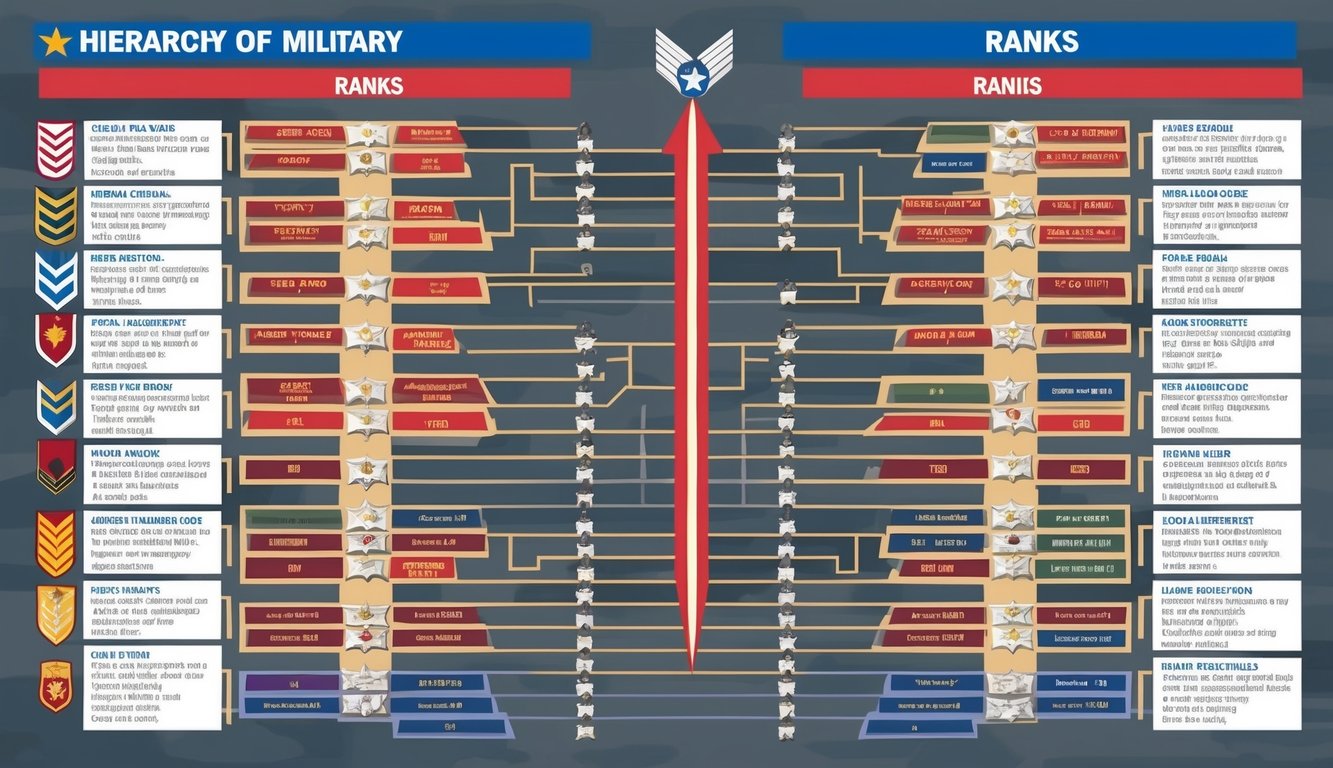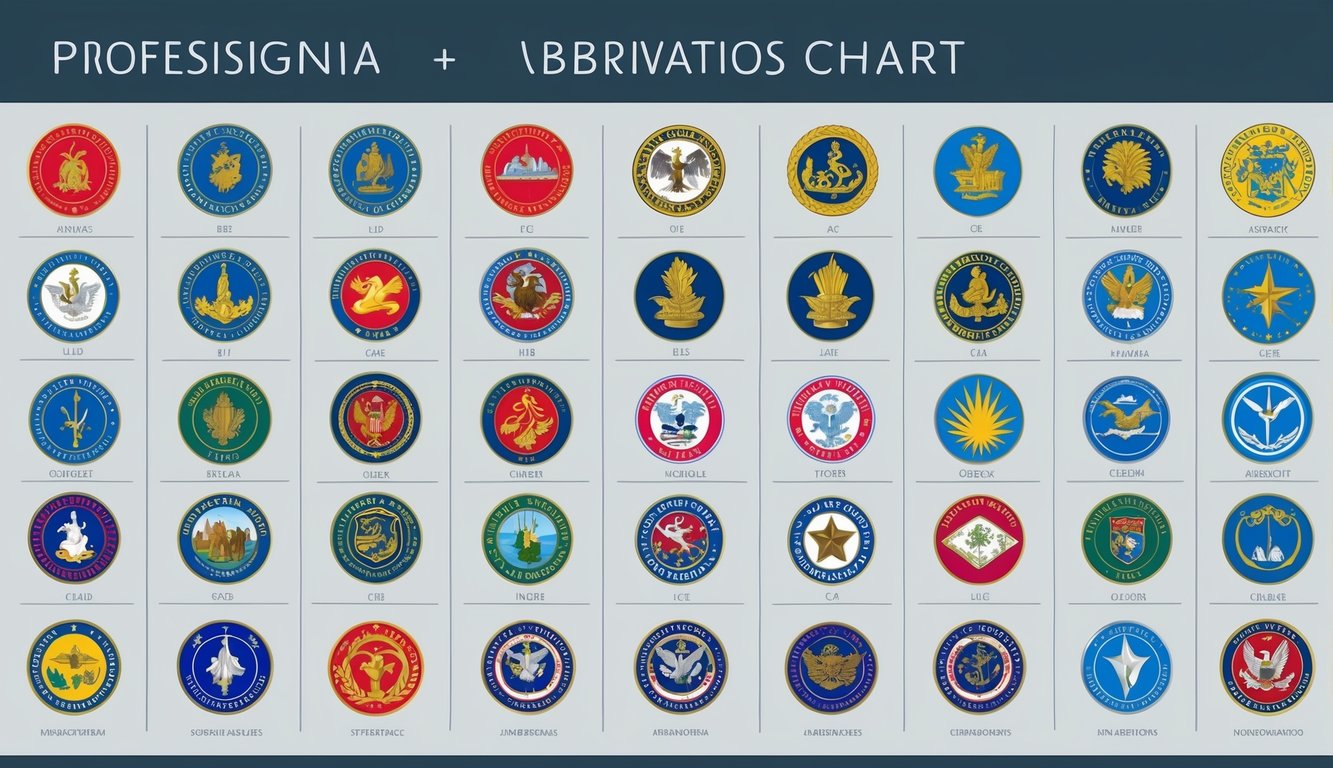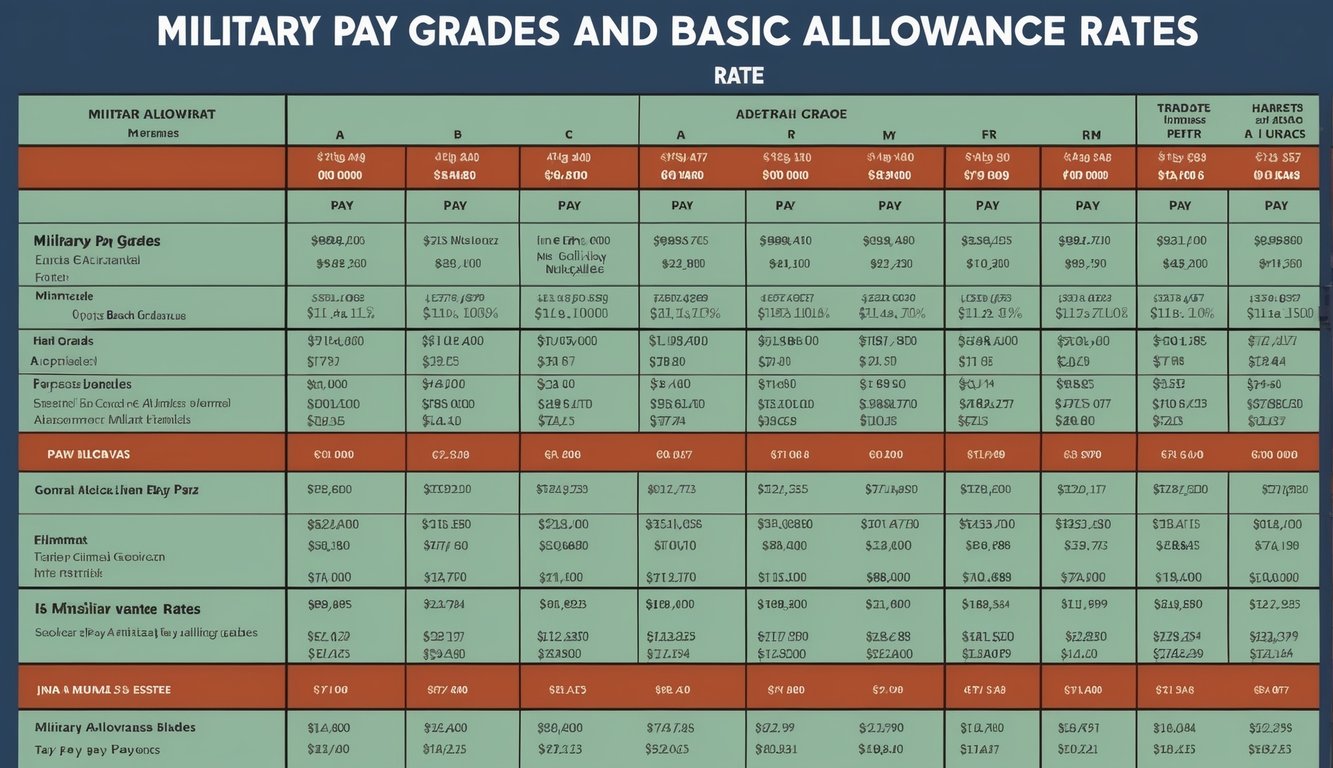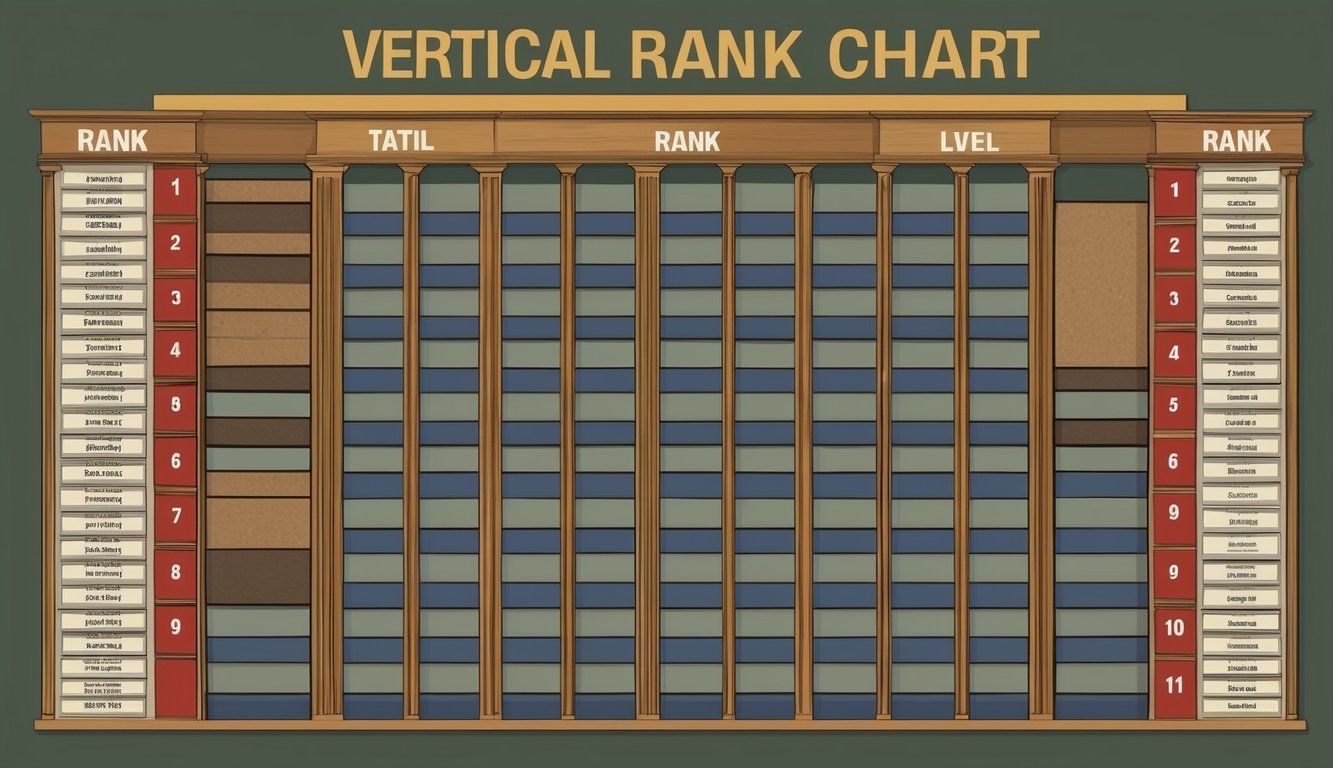Rank charts offer a straightforward visual depiction of hierarchies within organizations, particularly in military and governmental frameworks.
These diagrams illustrate the journey from entry-level roles up to senior leadership positions, providing a quick understanding of the chain of command.
Typically, rank charts include insignia, titles, and the responsibilities linked to each level, offering clarity into the duties and authority held at various positions.
Military rank charts are notably detailed, outlining the progression from enlisted members to commissioned officers.
You’ll encounter well-known titles such as Private, Sergeant, Lieutenant, and General, each represented by distinct insignia and pay grades.
These charts enhance your understanding of the intricate structures within the armed forces and the career pathways accessible to service members.
In addition to military applications, rank charts are utilized in various sectors, including law enforcement, fire services, and certain corporate environments.
They serve as an efficient means for identifying reporting relationships and the levels of experience or authority expected for different roles.
Whether you’re exploring a career within a structured organization or are simply interested in understanding how these organizations function, rank charts present essential information in a clear, user-friendly manner.
Key Takeaways
- Rank charts visually represent hierarchies and professional growth within organizations
- Military rank charts detail insignia, titles, and responsibilities for each level
- Grasping rank structures assists you in navigating career pathways and organizational dynamics
Understanding Military Ranks

Military ranks are fundamental to the command structure in armed forces globally, signifying authority, responsibility, and levels of experience within the military hierarchy.
The Basics of Rank Structure
Military ranks are categorized into three primary groups: enlisted, warrant officers, and commissioned officers.
The majority of military personnel are enlisted members, performing specific tasks and receiving training in particular skills.
Warrant officers are specialized technical experts who fill the gap between enlisted members and commissioned officers, providing essential leadership through their extensive knowledge in specialized fields.
Commissioned officers occupy the highest ranks, overseeing strategic planning, decision-making, and overall guidance.
Typically, they enter the military with a college degree.
Each rank has unique insignia, generally displayed on uniforms.
These visual identifiers enable quick recognition of a soldier’s position and authority.
Distinction Between Officers and Enlisted
The primary distinction between officers and enlisted members pertains to their functions and responsibilities.
Officers are focused on strategy, leadership, and management, making high-level decisions and being accountable for the performance of their units.
Enlisted personnel are responsible for executing day-to-day operations and specializing in specific tasks, forming the essential support for military operations through the implementation of plans and maintenance of equipment.
Non-commissioned officers (NCOs) are senior enlisted individuals who act as the conduit between officers and junior enlisted troops, providing direct supervision and mentorship.
Promotion through the ranks is determined by factors such as time in service, performance evaluations, and potential for leadership.
As you ascend the ranks, your responsibilities and authority expand correspondingly.
Insignia and Abbreviations

Military rank insignia and abbreviations are crucial for recognizing personnel and their corresponding roles throughout the armed forces.
These visual and written symbols help sustain order and organization within military entities.
Recognizing Insignia Across Branches
Each branch of the U.S. military utilizes distinct insignia to signify rank.
- Army and Air Force enlisted members typically wear chevrons on their uniforms.
- Navy and Coast Guard enlisted personnel display rating badges and chevrons on their sleeves.
- Marine Corps enlisted insignia features crossed rifles beneath chevrons.
- Officer insignia usually consists of bars, oak leaves, eagles, or stars, with slight differences amongst branches.
Pay close attention to the shape, color, and placement of these symbols to swiftly identify a service member’s rank and their respective branch.
Abbreviations and Stripes
Military rank abbreviations provide a concise way to refer to various positions.
For example, PVT refers to Private, CPL to Corporal, and SGT to Sergeant in the Army and Marine Corps.
In the Navy and Coast Guard, you’ll encounter abbreviations like SA for Seaman Apprentice and PO3 for Petty Officer Third Class.
The Air Force employs AB for Airman Basic and SSgt for Staff Sergeant.
Stripes often correspond with these abbreviations, as more stripes typically indicate a higher ranking among enlisted personnel.
Conversely, officers’ insignia do not utilize stripes but instead display distinct symbols to represent rank advancement.
Enlisted Ranks and Responsibilities
The enlisted ranks within the U.S. military lay the groundwork for the armed forces, encompassing a vast array of roles and responsibilities from new recruits to seasoned leaders with extensive experience.
Entry-Level Enlisted Ranks
New recruits typically start at the lower tier of enlisted ranks.
In the Army, these entry-level positions include Private (PVT), Private Second Class (PV2), and Private First Class (PFC).
In the Navy, you’ll begin as a Seaman Recruit.
At these ranks, the focus lies in acquiring foundational military skills and adjusting to the military lifestyle.
Key responsibilities include:
- Completing basic training
- Learning military customs and courtesies
- Developing physical fitness
- Mastering individual soldier skills
Non-Commissioned Officers (NCOs)
As you advance, you may become a Non-Commissioned Officer (NCO).
This category includes Corporals and Sergeants.
NCOs play a critical role in day-to-day operations and serve as the military’s frontline supervisors.
Your responsibilities as an NCO will include:
- Leading small teams of soldiers
- Training and mentoring junior enlisted personnel
- Enforcing discipline and standards
- Assisting officers in mission planning and execution
NCOs are often referred to as the “backbone” of the military due to their practical leadership and expertise.
Senior Non-Commissioned Officers
At the upper echelons of the enlisted ranks are Senior NCOs, comprising titles such as Sergeant First Class, Master Sergeant, and First Sergeant in the Army.
In the role of Senior NCO, you’ll assume significant leadership responsibilities, which include:
- Managing larger units or departments
- Advising officers on enlisted personnel matters
- Developing and implementing training programs
- Serving as subject matter experts in your specialized area
The highest enlisted rank in each branch (like Sergeant Major of the Army or Master Chief Petty Officer of the Navy) serves as the senior enlisted advisor to the top leaders of their respective services.
Officer Ranks and Career Progression

The U.S. military has a well-defined framework for officer career advancement, progressing through several ranks.
Officers move from junior to senior levels, gaining greater responsibilities and leadership chances along the way.
Junior Officers
As a new commissioned officer, you will start as a Second Lieutenant in the Army, Air Force, or Marines, or an Ensign in the Navy.
After approximately two years, you will likely advance to First Lieutenant or Lieutenant Junior Grade.
By around your four-year mark, you can expect promotion to Captain (or Lieutenant in the Navy).
Junior officers typically lead platoons or small units, acquiring important leadership experience and honing their expertise in their respective branches, whether it’s infantry, armor, or aviation.
This phase is essential for developing a foundation in military operations and tactics.
Field-Grade Officers
After approximately ten years of service, you may earn promotion to Major, with Lieutenant Colonel following around year sixteen, typically achieving the full Colonel rank after twenty-two years.
These ranks carry increased responsibility and focus on strategic planning.
As a field-grade officer, you will command larger units or become involved in higher-level staff positions.
Your responsibilities will shift from direct leadership to operational and strategic tasks, potentially overseeing battalions, regiments, or even entire military installations.
General Officers
The peak of an officer’s career consists of ascending to general officer ranks.
Beginning with Brigadier General (one-star), you can progress to Major General (two-star), Lieutenant General (three-star), and ultimately General (four-star).
These positions are highly competitive and limited in availability.
As a general, your responsibilities encompass leading major commands, policymaking, and overseeing top-level military strategies.
Only a select few attain the highest rank of General of the Army (five-star), usually in times of war.
Warrant Officer Track
Warrant officers function as technical experts in specialized areas within the U.S. Army, bridging the divide between enlisted members and commissioned officers, combining practical experience with leadership responsibilities.
Warrant Officer Roles and Ascension
As a warrant officer, you will progress through five ranks: from Warrant Officer 1 (WO1) to Chief Warrant Officer 5 (CW5).
Your journey begins with selection and attendance at Warrant Officer Candidate School.
Upon appointment, you will become a WO1, concentrating on developing technical expertise.
As you advance to Chief Warrant Officer 2 (CW2), your leadership roles will expand, allowing you to mentor junior officers.
As a CW3, you will be a senior expert in your field, while CW4s are regarded as master-level technical and tactical specialists.
The pinnacle of your career, CW5, includes comprehensive leadership and advisory positions.
Advancement necessitates sufficient time in grade, completion of professional development courses, and selection board endorsement.
This career path provides unique opportunities to mesh technical mastery with leadership capabilities.
Military Pay Grades and Basic Allowance

Military compensation is derived from base pay along with various allowances.
Pay grades dictate your fundamental pay, while allowances such as BAS provide supplemental financial support.
Pay Grades Explained
The military employs a standardized pay grade system for determining base pay, with enlisted members ranging from E-1 to E-9.
New recruits typically commence at E-1.
As you rise in rank, your pay also increases.
For instance, in 2024, an E-1 with less than two years of service earns $2,017.20 per month in basic pay.
Senior ranks like E-8 and E-9 offer higher pay, necessitating extensive experience and leadership capabilities.
Your duration of service additionally impacts your compensation.
Even within the same grade, you will earn more with increased years of experience.
Understanding Basic Allowance for Subsistence (BAS)
BAS is a monthly allowance designed to help offset the cost of meals; it is not intended to cover your family’s food expenses.
All service members qualify for BAS, irrespective of whether they utilize military dining facilities.
The amount remains uniform for all enlisted members, regardless of rank or family size.
BAS rates adjust annually in accordance with changes in food costs.
For specific amounts, consult the current year’s rates on the Defense Finance and Accounting Service website.
Importantly, BAS is separate from your basic pay and is not subject to taxation, forming a vital part of your overall military compensation package.
Organizational Structure and Divisions
Military organizations are characterized by complex hierarchies and specialized divisions that ensure efficient operations and clarity in the chain of command.
These structures promote effective coordination and mission execution across diverse branches and roles.
Branch Divisions and Specializations
The U.S. military consists of five primary branches: Army, Navy, Marine Corps, Air Force, and Coast Guard, each having distinct roles and specializations.
The Army concentrates on ground operations, the Navy focuses on maritime missions, the Marine Corps serves as an expeditionary force, the Air Force oversees air and space operations, and the Coast Guard manages maritime law enforcement and search and rescue during peacetime under the Department of Homeland Security.
Each branch hosts further divisions based on specific functions and geographic areas.
For instance, the Army comprises combat arms, combat support, and combat service support units, while the Air Force organizes into numbered air forces and wings.
Command Hierarchy and Roles
Military rank charts illustrate a transparent chain of command.
At the pinnacle are high-ranking officers such as the Commandant of the Marine Corps or the Chief of Staff of the Army, who supervise their corresponding branches and report to civilian leadership.
Below them, a variety of officer and enlisted ranks create a pyramid structure, with each tier holding defined responsibilities and authority.
For example, company commanders direct units of 100-200 soldiers, while squad leaders oversee smaller teams.
Your role in this hierarchy is influenced by your rank and Military Occupational Specialty (MOS), which delineates your job and skill set within the military, defining your training, assignments, and career progression within the organizational structure.
Joining the Military
Enlisting in the U.S. military provides a variety of career tracks and opportunities for personal growth.
You can choose to enlist as a recruit or pursue officer training, with each pathway offering distinct experiences and responsibilities.
Recruitment and Enlistment Process
To join as an enlisted member, your first step is meeting with a recruiter who will discuss your aspirations and assist in selecting a branch that aligns with your interests.
You must meet age, citizenship, and education requirements; for example, the U.S. Army requires individuals to be between 17-35 years old with a high school diploma or equivalent.
Next, you will take the Armed Services Vocational Aptitude Battery (ASVAB) test to assess your strengths.
Following a successful medical examination and background check, you will choose a job and sign your contract, after which basic training will commence to instill military skills and discipline.
Paths to Becoming an Officer
If your aim is to pursue leadership roles, becoming an officer may be your goal.
Several avenues exist:
- Military academies: Attend West Point or other service academies for a four-year degree and commissioning.
- ROTC: Participate in Reserve Officers’ Training Corps during college to earn your degree and commission at the same time.
- Officer Candidate School (OCS): If you already possess a bachelor’s degree, you may apply for OCS after enlisting.
Officer criteria are more stringent than those for enlisted personnel.
For the Army, candidates must be under 31 years old (or 27 for West Point) and hold a college degree.
As an officer, you’ll lead troops from the onset of your career and take on heightened responsibilities.
Frequently Asked Questions
Rank charts can take various forms for manifold purposes.
From tournaments to military hierarchies and even video game rankings, these visual aids help structure and contrast information.
Below are answers to common queries about creating and using rank charts.
How can I create a custom rank chart for a tournament?
To create a custom tournament rank chart, begin by listing all participants.
Establish columns for wins, losses, and points.
Utilize spreadsheet software to sort and rank players based on their scores, and consider incorporating color-coding or visual elements to accentuate top performers.
Bracket-style templates may be beneficial for elimination tournaments.
What’s the best way to organize military ranks in a chart?
For military rank charts, adopt a pyramid format, positioning higher ranks at the top and broader tiers below for lower ranks.
Incorporate insignia images alongside each rank.
Distinguish between branches like Army, Navy, and Air Force with separate columns.
Maintain consistent formatting and color schemes to differentiate rank categories.
Can you recommend some tools for making tier lists?
TierMaker and TierListMaker are popular free online tools for constructing tier lists, allowing for drag-and-drop functionality and customizable tiers.
For advanced features, consider using Canva or Adobe Illustrator, which provide enhanced control over design elements and enable more intricate layouts.
Where can I find a downloadable rank chart template?
Microsoft Office and Google Sheets offer free downloadable templates for rank charts.
Sport-specific templates may be found on sites like Template.net or Smartsheet.
For more specialized options, explore design marketplaces such as Creative Market or GraphicRiver.
Always adapt templates to meet your individual requirements.
Is there a standard format for football ranking charts?
Football ranking charts generally comprise columns for team name, wins, losses, ties, and points.
You might also include goal differentials or head-to-head records.
Utilizing team logos enhances visual appeal.
For league standings, categorize teams by division first and then by overall rank.
Regular updates reflect current season performances.
How to Include Different Levels in a Fortnite Rank Chart
To create a Fortnite rank chart, start with the lowest level (Open League) at the bottom, progressing through Bronze, Silver, Gold, and Platinum leagues.
Specify the point thresholds for each rank, using Fortnite’s official rank icons if accessible.
Finally, incorporate Arena Hype points necessary for each division to provide players with clear objectives.

